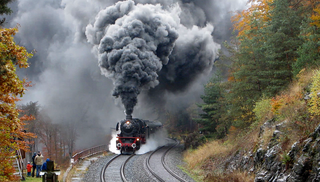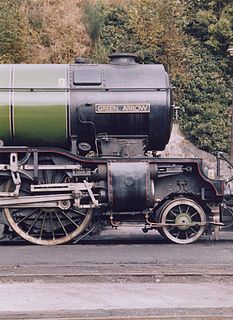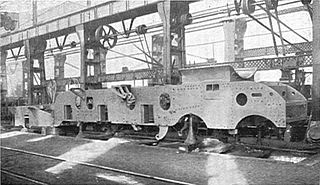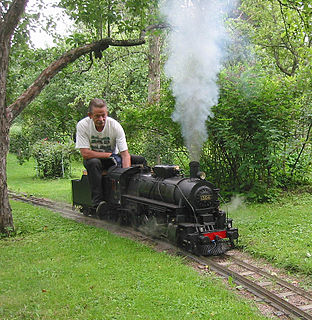
The Walschaerts valve gear is a type of valve gear invented by Belgian railway mechanical engineer Egide Walschaerts in 1844 used to regulate the flow of steam to the pistons in steam engines. The gear is sometimes named without the final "s", since it was incorrectly patented under that name. It was extensively used in steam locomotives from the late 19th century until the end of the steam era.

The GWR 4100 Class was a class of steam locomotives in the Great Western Railway (GWR) of the United Kingdom.
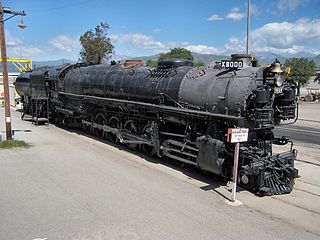
Under the Whyte notation for the classification of steam locomotives, 4-12-2 represents the wheel arrangement of four leading wheels, twelve coupled driving wheels, and two trailing wheels. This arrangement was named the Union Pacific type, after the only railroad to use it.
The Caledonian Railway 956 Class were 3-cylinder 4-6-0 steam locomotives that were used on the Caledonian Railway from 1921. They were built to the design of William Pickersgill. At the time they were the largest design operated by a Scottish railway.

The London and North Eastern Railway LNER Gresley Classes A1 and A3 locomotives represented two distinct stages in the history of the British 4-6-2 "Pacific" steam locomotives designed by Nigel Gresley. They were designed for main line passenger services, initially on the Great Northern Railway (GNR), a constituent company of the London and North Eastern Railway after the amalgamation of 1923, for which they became a standard design. The change in class designation to A3 reflected the fitting to the same chassis of a higher pressure boiler with a greater superheating surface and a small reduction in cylinder diameter, leading to an increase in locomotive weight. Eventually all of the A1 locomotives were rebuilt, most to A3 specifications, but no. 4470 was completely rebuilt as Class A1/1.
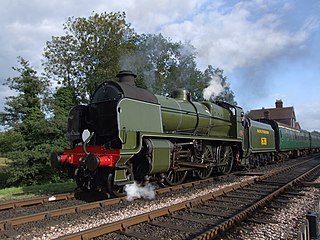
The SR U class were 2-6-0 (mogul) steam locomotives designed by Richard Maunsell for passenger duties on the Southern Railway (SR). The class represented the penultimate stage in the development of the Southern Railway’s 2-6-0 mogul type "family", which improved upon the basic principles established by GWR Chief Mechanical Engineer (CME) George Jackson Churchward for Great Western Railway (GWR) locomotives. The U class design drew from experience with the GWR 4300s and N classes, improved by applying Midland Railway ideas to the design, enabling the SECR to influence development of the 2-6-0 in Britain.

The Stephenson valve gear or Stephenson link or shifting link is a simple design of valve gear that was widely used throughout the world for all kinds of steam engines. It is named after Robert Stephenson but was invented by his employees.

The SR U1 class were three-cylinder 2-6-0 ('mogul') steam locomotives designed by Richard Maunsell for passenger duties on the Southern Railway. The fifth member of the Maunsell "family" of standardised moguls and 2-6-4 locomotives, the U1 was the final development of the Maunsell mogul, and marked a continuation of the basic principles established by CME George Jackson Churchward for the GWR. Developed from Maunsell's previous SR U class design, the U1 class shared characteristics with Churchward’s GWR 4300 Class.

The New Zealand G class was a type of Garratt steam locomotive used in New Zealand, the only such Garratt type steam locomotives ever used by the New Zealand Railways Department (NZR). They were ordered to deal with traffic growth over the heavy gradients of the North Island Main Trunk and to do away with the use of banking engines on steep grades. They were one of the few Garratt designs to employ six cylinders. A mechanical stoker was used to feed coal into the locomotive.

The LNER W1 No. 10000 was an experimental steam locomotive fitted with a high pressure water-tube boiler. Nigel Gresley was impressed by the results of using high-pressure steam in marine applications and so in 1924 he approached Harold Yarrow of shipyard & boilermakers Yarrow & Company of Glasgow to design a suitable boiler for a railway locomotive, based on Yarrow's design.

The SECR N class was a type of 2-6-0 ("mogul") steam locomotive designed in 1914 by Richard Maunsell for mixed-traffic duties on the South Eastern and Chatham Railway (SECR). Built between 1917 and 1934, it was the first non-Great Western Railway (GWR) type to use and improve upon the basic design principles established by GWR Chief Mechanical Engineer (CME) George Jackson Churchward. The N class was based on the GWR 4300 Class design, improved with Midland Railway concepts.

The LNER Class A1/1 consisted of a single 4-6-2 "Pacific" express passenger locomotive rebuilt in 1945 from an A1 class locomotive, by Edward Thompson. It was intended as the prototype of a new design of pacific locomotives improving the A4 design of Thompson’s predecessor Sir Nigel Gresley. No further examples were built due to Thompson’s retirement in 1946.

The cylinder is the power-producing element of the steam engine powering a steam locomotive. The cylinder is made pressure-tight with end covers and a piston; a valve distributes the steam to the ends of the cylinder. Cylinders were cast in cast iron and later in steel. The cylinder casting includes other features such as valve ports and mounting feet. The last big American locomotives incorporated the cylinders as part of huge one-piece steel castings that were the main frame of the locomotive. Renewable wearing surfaces were needed inside the cylinders and provided by cast-iron bushings.

The SECR N1 class was a type of 3-cylinder 2-6-0 ('mogul') steam locomotive designed by Richard Maunsell for mixed traffic duties, initially on the South Eastern and Chatham Railway (SECR), and later operated for the Southern Railway (SR). The N1 was a development of the basic principles established by the Great Western Railway's (GWR) Chief Mechanical Engineer (CME) George Jackson Churchward and by Maunsell's previous N class design.

The SECR K class was a type of 2-6-4 tank locomotive designed in 1914 by Richard Maunsell for express passenger duties on the South Eastern and Chatham Railway (SECR), which operated between London and south-east England. The Southern Railway (SR) K1 class was a three-cylinder variant of the K class, designed in 1925 to suit a narrower loading gauge. They were among the first non-Great Western Railway (GWR) types to use and improve upon the basic design principles of power and standardisation established by GWR Chief Mechanical Engineer (CME) George Jackson Churchward. The locomotives were based on the GWR 4300 class, improved by the Midland Railway's ideals of simplicity and ease of maintenance.
A divided drive locomotive is a steam locomotive that divides the driving force on its wheels by using different cylinders to power different pairs of driving wheels in order to give better weight distribution and reduce "hammer blow" which can be damaging to the track, or else to enable the wider spacing of the driving wheels to accommodate a larger firebox.
GCR Class 9P was a design of four-cylinder steam locomotive of the 4-6-0 wheel arrangement built for hauling express passenger trains on the Great Central Railway in England. A total of six were built: one in 1917, and five in 1920. They were sometimes known as the Lord Faringdon class, from the name of the first one built.


